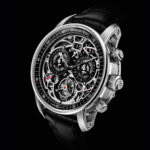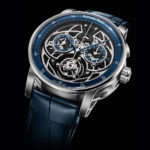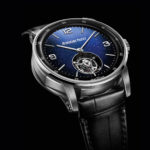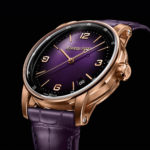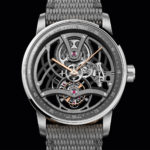Editorial: An Appraisal of the Audemars Piguet Code 11.59 Universelle
An admiring but realistic critique.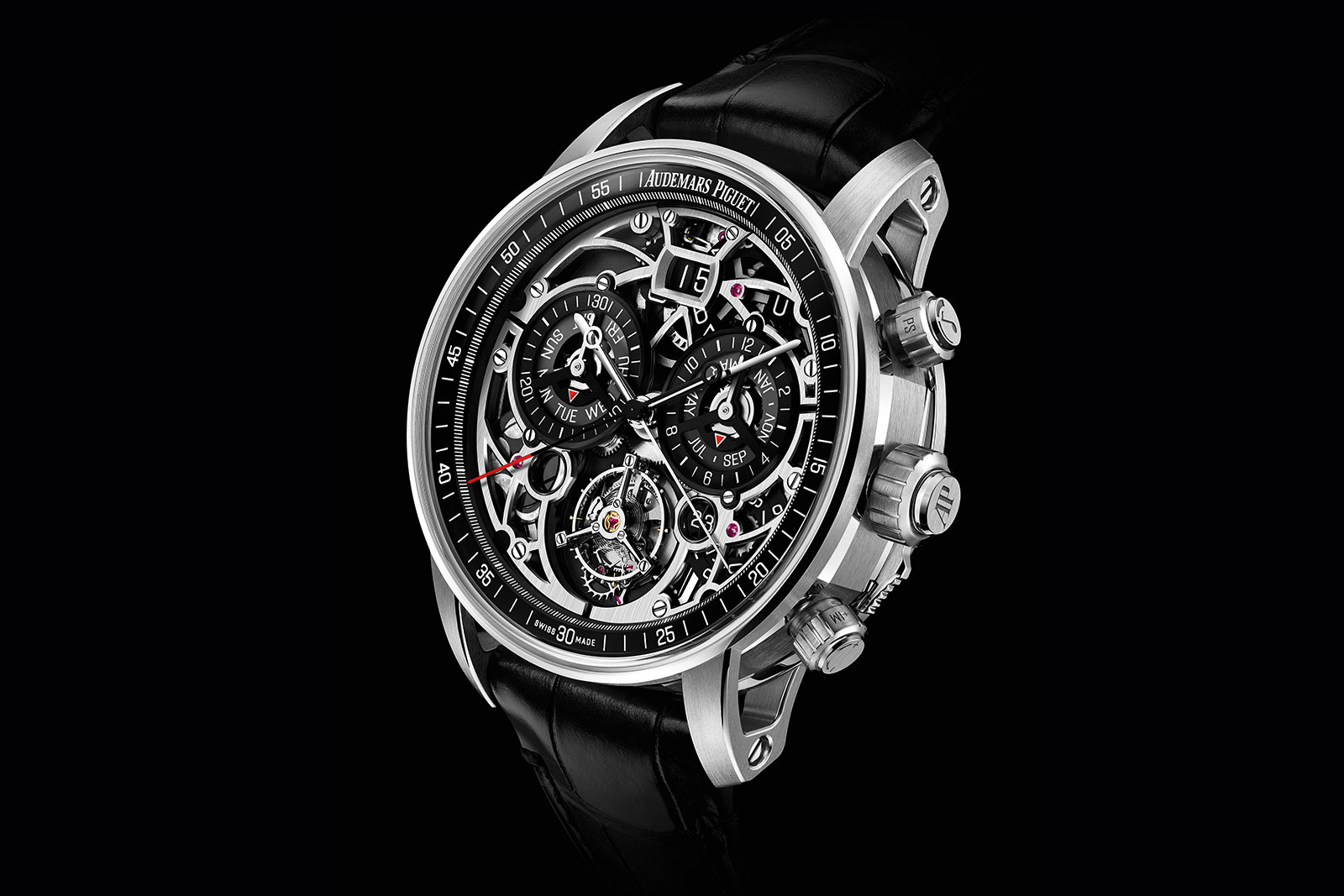
Audemars Piguet recently launched more than a dozen new models and predictably it was the Royal Oaks that got the most attention. But the most impressive new release was unquestionably the Code 11.59 Universelle. It’s a grand complication that boasts multiple complications most cleverly executed, in a remarkably compact case – the size of the watch is an achievement in itself.
Though the Universelle is positively slender for a grand complication, it’s still a large watch. But criticising the Universelle for its somewhat ungainly looks is to miss the point completely. Just like a mid-engine Ferrari will never be a roomy vehicle capable of conveying four adults in comfort, a grand complication will never be a svelte watch. Even Francois-Paul Journe, a legendary talent who has long specialised in slim complications, needs a lot of volume to contain his most complicated watch, the double-sided Astronomic Souveraine.
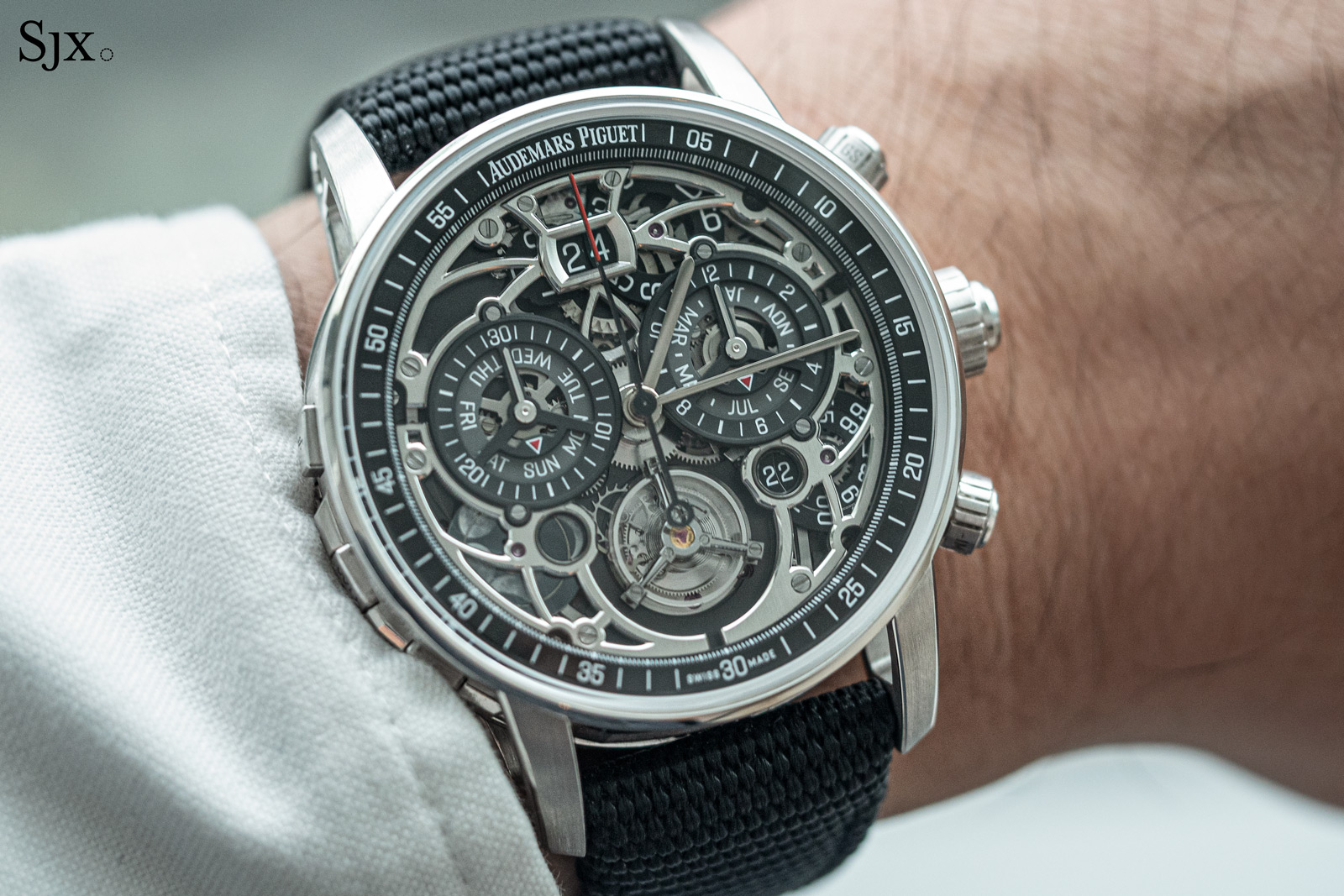
Grand complications, or more specifically mega complications, like the Universelle, are never pretty. That’s simply a matter of necessity – the mechanical complexity inevitably results in an enormous case and confusing dial. The F.P. Journe Astronomic, Patek Philippe Grandmaster Chime, and Vacheron Constantin Tour de l’Ile are all equally large and confusing. The Astronomic is the smallest of the lot and it’s still 44 mm by 13.7 mm. And the Grandmaster Chime is a titanic 47.7 mm by 16.07 mm.
I can confirm the Grandmaster Chime is titanic no matter how you measure it. I had the fortune of wearing a one for a while indoors. Poor ergonomics and an intimidatingly complex interface are its defining features, but the watch is monumental, both in terms of size and complications. It feels like the kind of watch for someone who is truly master of his own destiny, the kind of individual who doesn’t have to worry about elections or shareholders.
Watches like the Grandmaster Chime are impressive objects for the wrist, which makes them status symbols. Even at a distance, they are evidently massive, heavy, and intricate. That’s why the Grandmaster Chime is the ultimate watch for a certain class of collector, instead of an ultra-light Richard Mille.
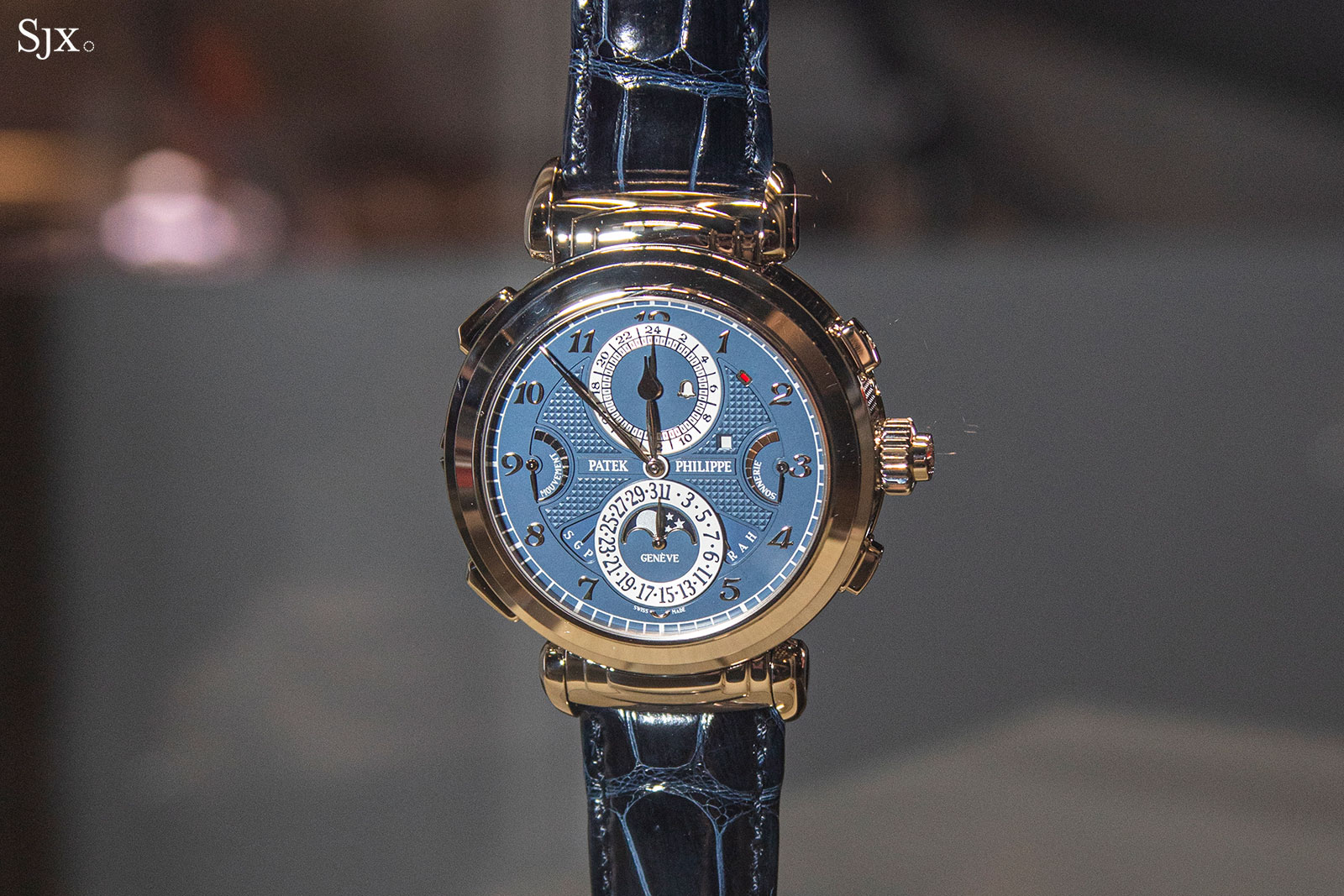
The Patek Philippe Grandmaster Chime ref. 6300G
In contrast, the Universelle is much more wearable. It does not feel like a watch with two dozen complications inside (we’ll get to the complication count later).
In fact, the Universelle is probably too wearable. I feel it is insufficiently over-the-top – not imposing enough, not elaborate enough, and not obvious enough. Relative to the competition, the Universelle is to subtle, which will circumscribe its appeal (admittedly a moot point since only seven will be made this year and only double that next year).
But the Universelle should be maximalist – either classically baroque or hyper technical – enough to be instantly recognisable at a distance. That because grand complications are statement objects, even historically. As a matter of fact, the inspiration for the Universelle was just that – maximalist.
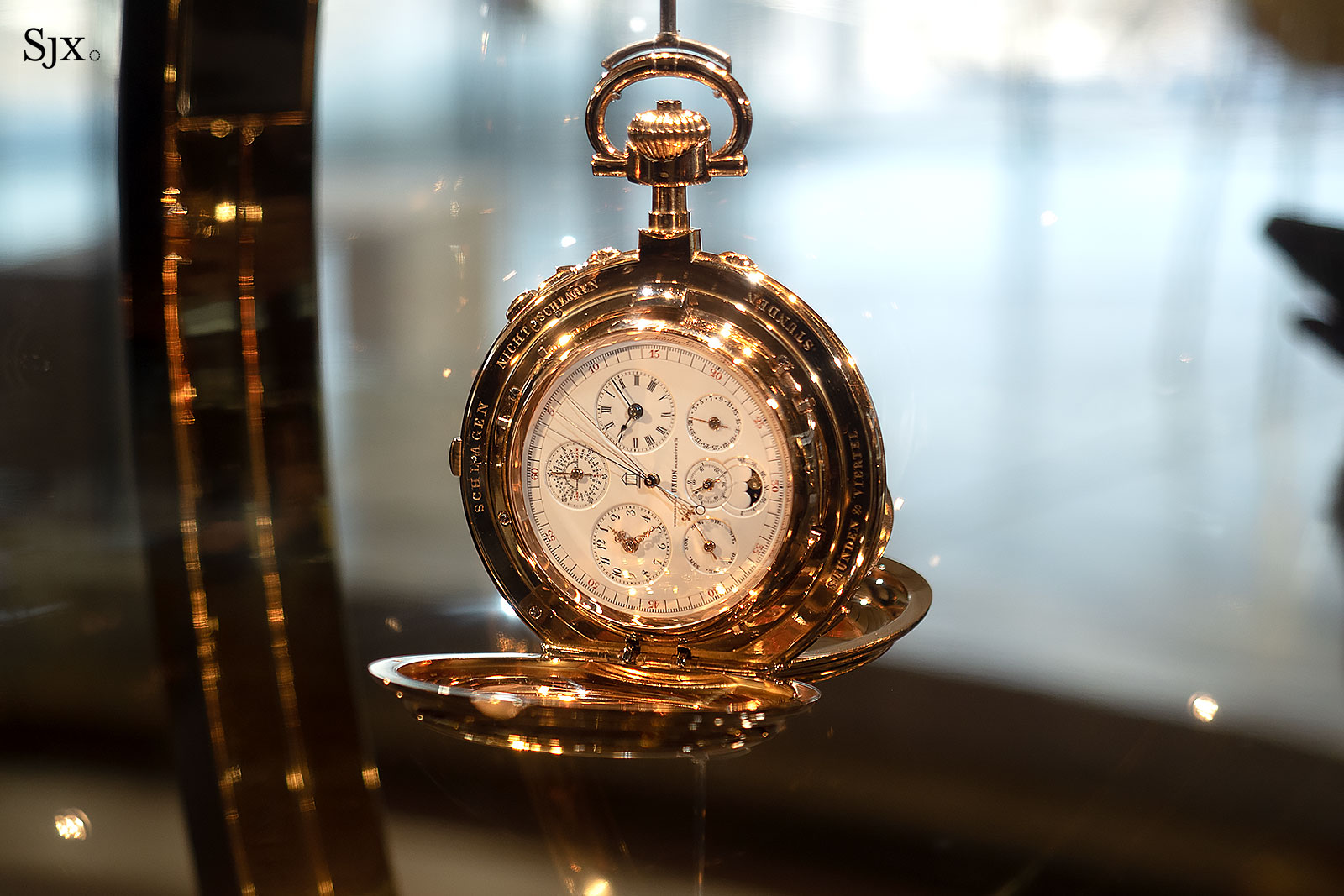
At the centre of the Audemars Piguet Museum sits l’Universelle
The 1899 timepiece known as l’Universelle was shaped like a pocket watch but is gigantic it would never fit into a pocket, making it essentially an immovable timekeeper, the ultimate desk clock.
Interestingly, l’Universelle was originally presented in a yellow gold case, as it is now exhibited in the Audemars Piguet Museum. But its prior owner, London-based watch dealer Marcus Margulies, commissioned a platinum case for the pocket watch, giving it a marginally more restrained aesthetic. But AP has since returned the watch to its turn-of-the-century glory by reinstalling the original yellow gold case.
Ingenious and concise
While its comparatively diminutive case might suggest it’s a lesser grand complication, the Universelle is decidedly not. Instead, the technical merits of the cal. 1000 within are substantial.
It manages to cram everything – almost two dozen complications – into a relatively compact package. The cal. 1000 is under 9 mm, while the case is 15.55 mm. And remember that the case is thicker than a conventional watch because it has a triple-layer back made up of a sapphire window followed by the Supersonnerie double back.
To put those measurements in perspective, the Universelle is a smaller watch than the Lange Triple Split that has a 15.6 mm case and 9.4 mm movement. Even though the Triple Split is likely the most advanced chronograph in modern watchmaking, it is not as complicated as the Universelle.
The cal. 1000 manages to do that with concise engineering that streamlines as much as possible. Some of the smart ideas are borrowed from other AP watches, like the extra-flat perpetual calendar mechanism derived from that in the Royal Oak Perpetual Calendar Ultra Thin. So the 48-tooth month wheel for the calendar, for instance, has a single layer of teeth.
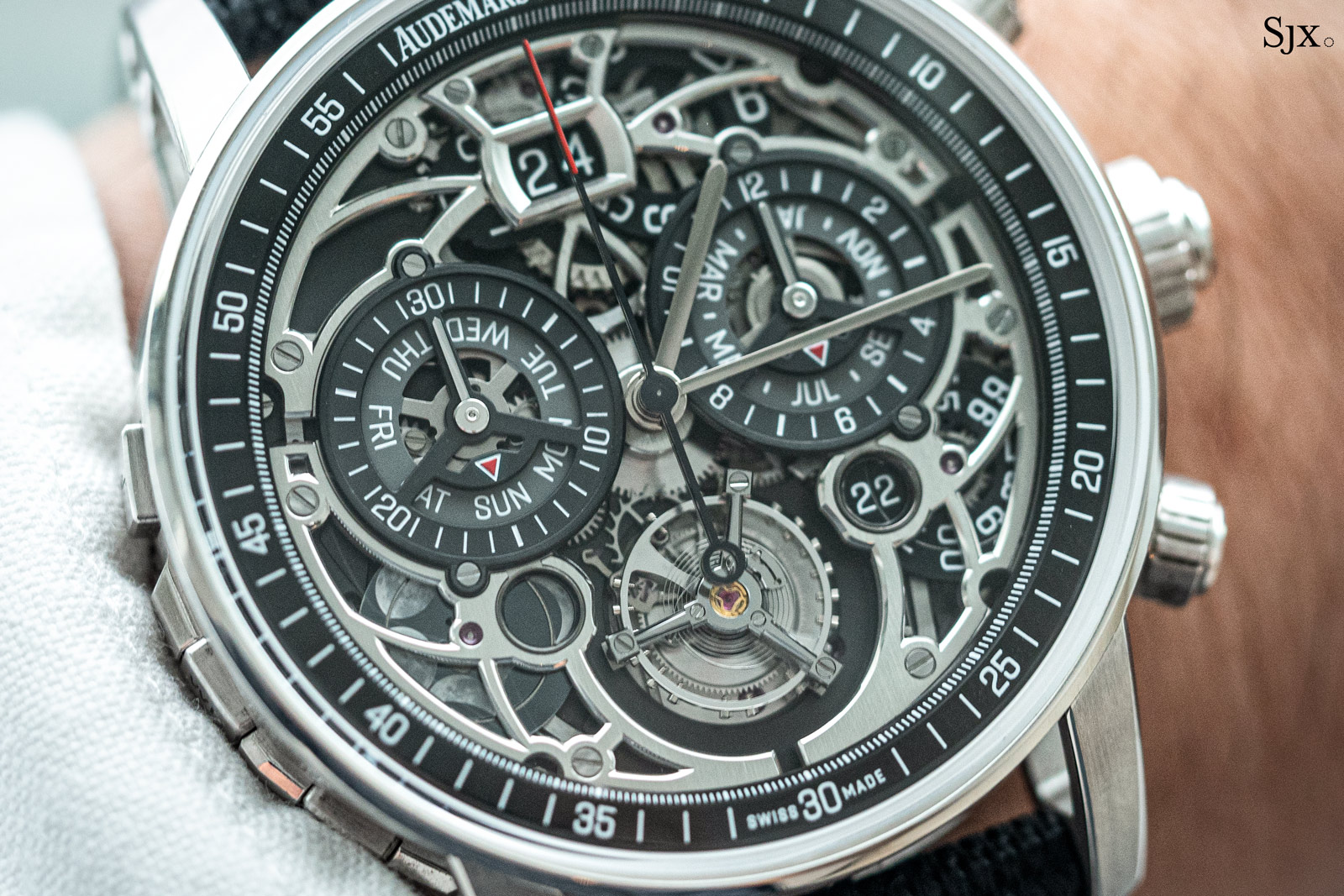
The open-dial version of the Universelle
But with more space available, the cal. 1000 improves on the complications even if original idea was taken from another movement. As a result, the perpetual calendar does one better and operates on a 400-year cycle – meaning it needs adjustment once every four centuries – a substantial advance over the 100-year cycle of a typical perpetual calendar.
But possibly the most notable is the split-seconds mechanism. Historically stacked upwards and positioned under the rotor in automatic chronographs, the split-seconds has always added substantial height to a chronograph.
In the cal. 1000 the split seconds is elegantly positioned: the mechanism is smartly contained within an aperture in the rotor, reducing the movement height by 1.5 mm according to AP technical chief Giulio Papi. While 1.5 mm might seem trivial, it’s 17% of the cal. 1000 thickness of 8.75 mm, equivalent to eliminating one floor from a five-storey building.
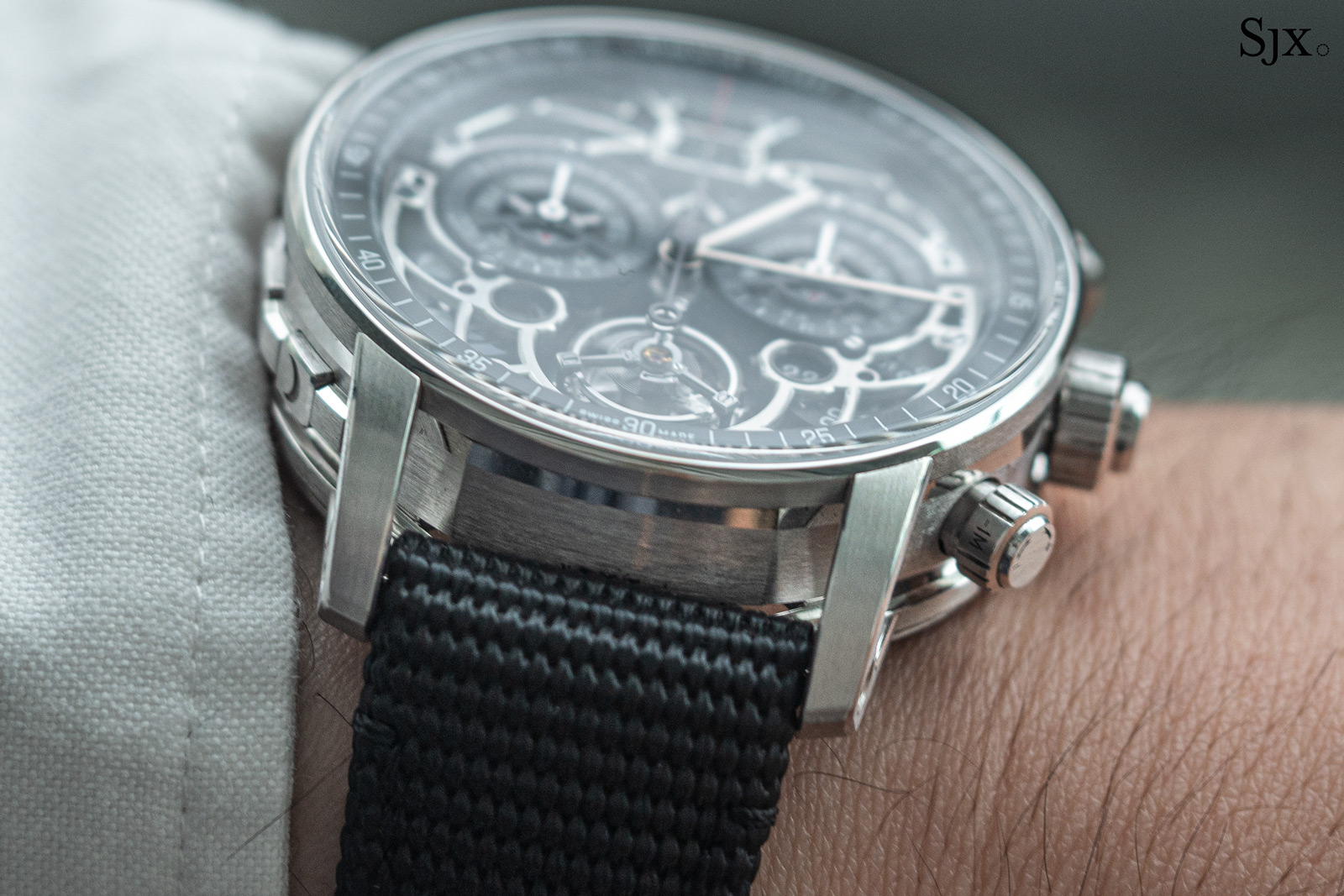
The Universelle in profile
And the cal. 1000 is easy to operate. Its complications can be accessed in an intuitive and straightforward manner thanks to a practical interface. Add to that 20 m of water resistance and the Universelle is a surprisingly practical watch.
The cal. 1000 is also constructed to minimise the potential for user error. Essentially every function in the watch can be activated, set, and adjusted without fear of breaking something. This robust approach was historically missing in grand complications and even mere complications, though it is gradually becoming more common.
But as is expected for such a complex movement, the cal. 1000 does contain compromises.
The grande sonnerie, for example, is installed on the base movement. But unlike other add-ons to the cal. 1000 that a recent builds, the grand sonnerie is the same mechanism found in the AP grande sonnerie movement from the mid 1990s. It’s a strong performer, especially when combined with the Supersonnerie double case back, but one can reasonably wish for something new given the cost and positioning of the Universelle.
And then there’s the less-than-stellar view from the back. The full rotor is an accomplishment in a movement as complicated as this, but it obscures most of the rest of the movement – there’s a lot going on inside but little of it can be admired. At the same time, the movement finishing is monochromatic, resulting in a lack of contrast that leaves the details difficult to discern.
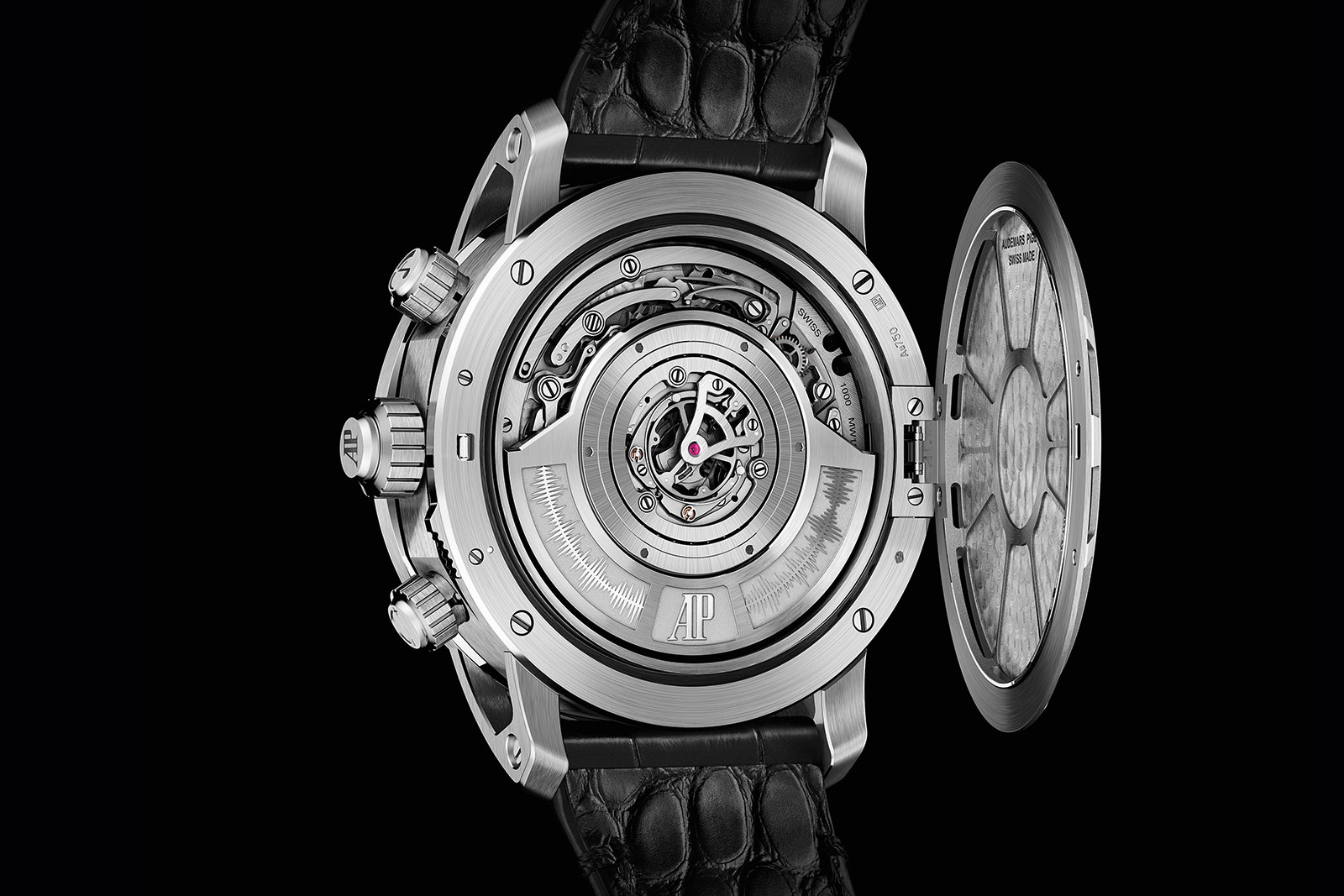
The cal. 1000 under the hinged Supersonnerie case back. Image – Audemars Piguet
A suite of movements
From a wider perspective, the cal. 1000 is illustrates AP’s cohesive movement strategy. At its heart the cal. 1000 shares the same architecture as the cal. 4401 chronograph movement but enhanced with add-ons like the grande sonnerie and split-seconds. Being able to develop a base calibre that can accommodate all that is an achievement in itself.
As a result of the shared platform, some of the complications in the cal. 1000 are also found in other movements. The Royal Oak Concept Split-Seconds Chronograph GMT shares the base calibre and also the split-seconds mechanism.
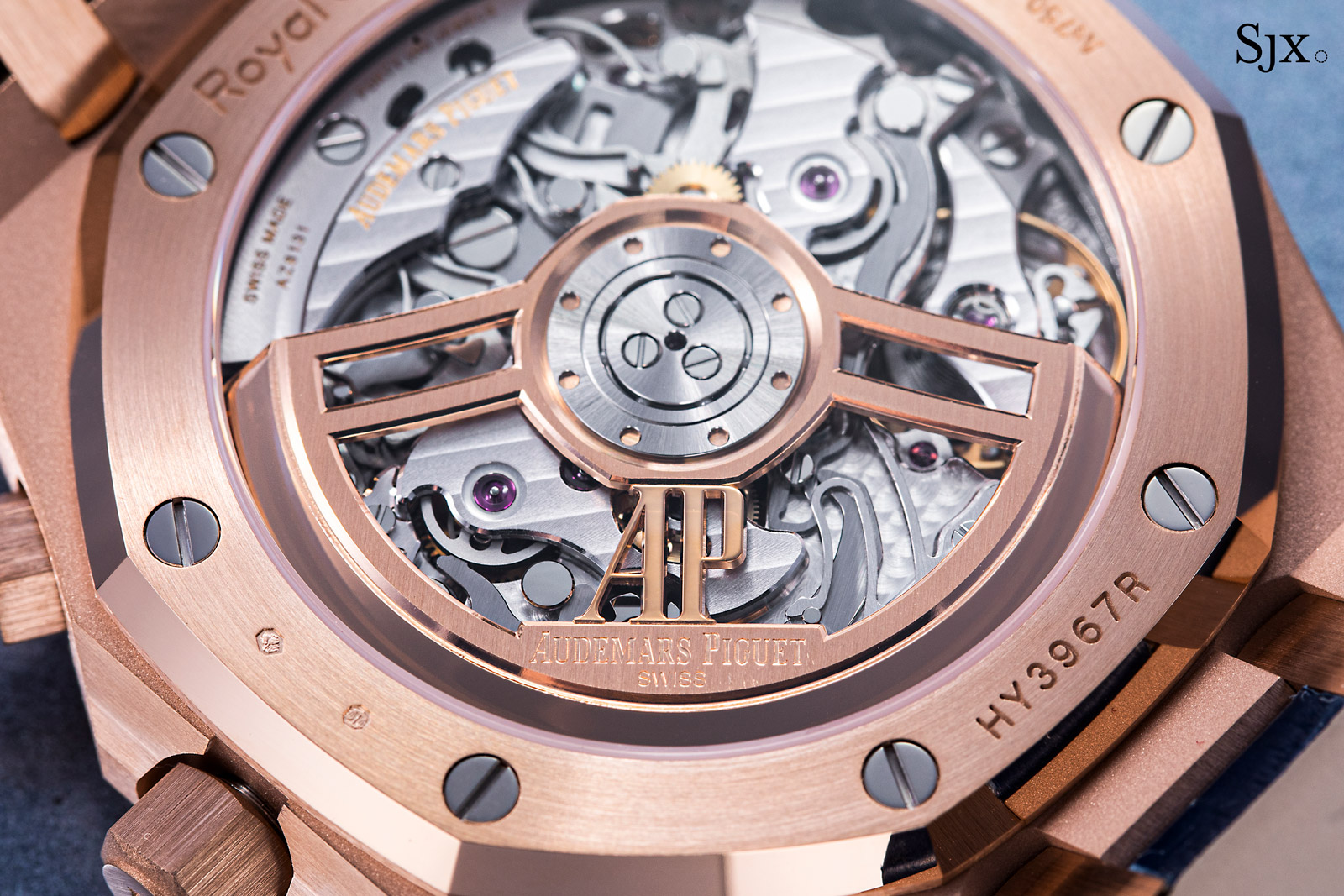
The cal. 4401, a relative of the cal. 1000
Granted, some collectors might frown at a top-of-the-line watch sharing the same underpinnings as the modest Royal Oak Chronograph, but in truth a majority of grand complications are powered by movements derived from other movements or movements that spawn other calibres.
The Patek Philippe ref. 6301P Grande Sonnerie, for example, is equipped with a movement derived from the base of the Grandmaster Chime, while the Vacheron Constantin Tour de l’Ile gave rise to a range of more modest complicated watches, including several one-off double-face watches.
Tallying the complications
According to AP, the complications count in the Universelle is 23 – and it is just that. In my short years observing the watch industry it is inevitable that the complications count of a new grand comp is criticised for being misleading.
The method used by AP to obtain the number breaks down what is typically regarded as a single complication into its constituent parts, like a perpetual calendar being five complications – day, date, month, moon phase, and year – instead of just one. But that’s exactly how it has been done since at least the 1980s.
The Patek Philippe Calibre 89 of 1989 has 33 complications, a number derived with the same methodology. And the same goes for the Vacheron Constantin Tour de l’Ile of 2005 (16) and the more recent F.P. Journe Astronomic (18). And even when “scholars” retroactively dissect the Henry Graves Supercomplication, the 24-compliation tally is arrived at in the same way.
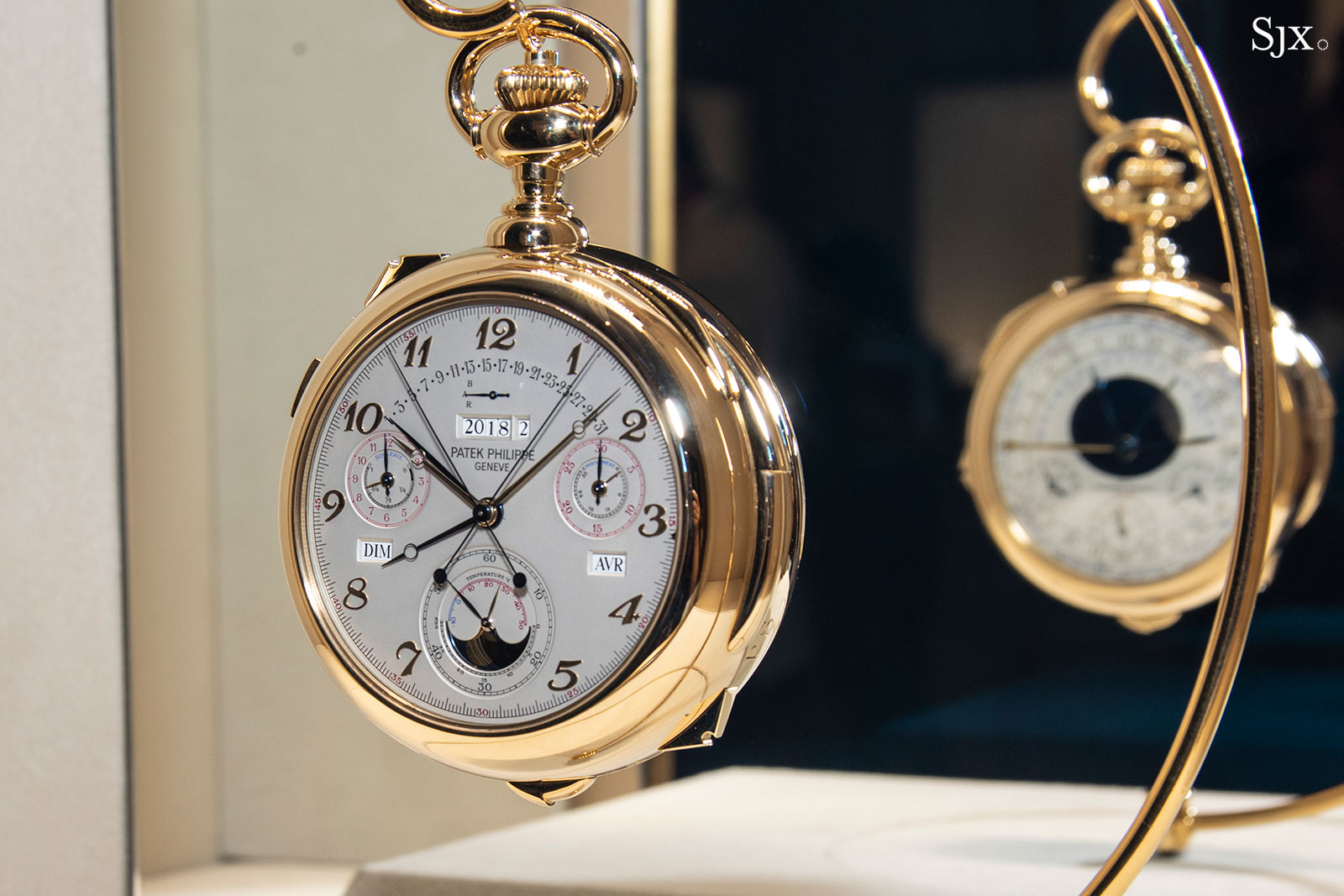
The Calibre 89
A technically-minded collector, however, might rightly dispute one particular mechanism in the Universelle – the tourbillon. As the sharply discerning owner of the Vacheron Constantin Vermeer grande sonnerie told me, his pocket watch boasts the pinnacle of traditional, elegant complications, but “not counting the tourbillon, which to me isn’t a complication”.
Historically, the tourbillon was considered a device to aid timekeeping, much like an overcoil hairspring or bimetallic balance, neither of which are considered complications, even by the most imaginative marketer.
That has changed over time in favour of the tourbillon. While Patek Philippe did not include the tourbillon in the complications count of the Calibre 89 in 1989, Vacheron Constantin and F.P. Journe did for the Tour de l’Ile and Astronomic respectively. In other words, in the context of contemporary watchmaking, the tourbillon is always accepted as a complication so the 23 complications in the Universelle is correct.
Back to top.
